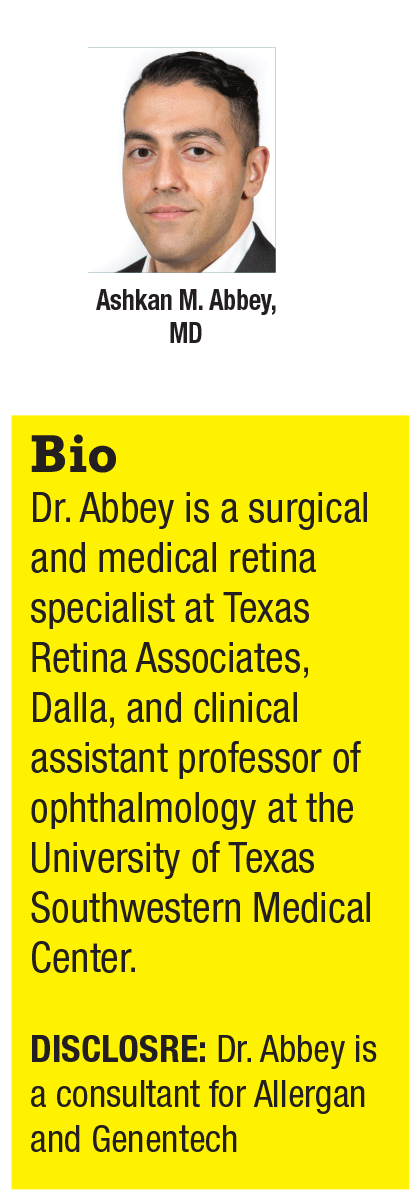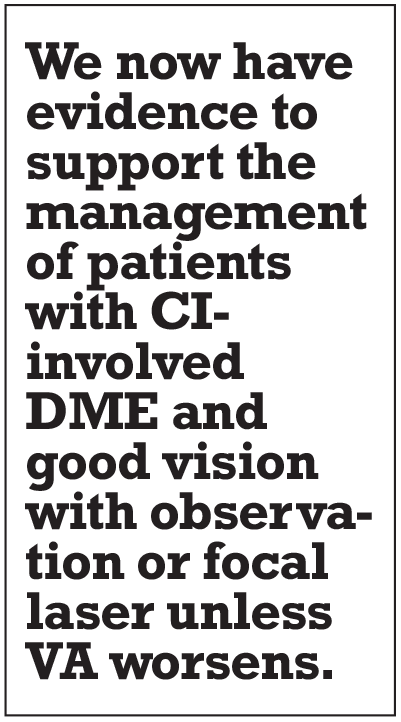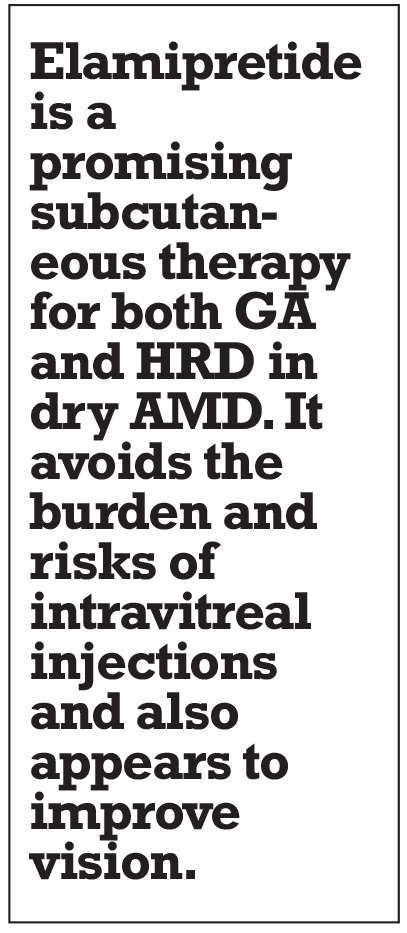 |
 |
The annual meeting of the Association for Research in Vision and Ophthalmology in Vancouver brought together the best retina researchers to explore the latest in diagnostics, treatment and management strategies. Every year, ARVO distinguishes itself from other ophthalmology meetings by including a broad spectrum of research, from innovative basic science to the latest clinical trials.
Here, we present summaries of five compelling posters and presentations: results from Protocol V of the Diabetic Retinopathy Clinical Research Network; a report about the disorganization of retinal inner layers as a biomarker for epiretinal membrane surgery; use of artificial intelligence to predict hemoglobin A1c (HbA1c) and to screen for diabetic retinopathy; and a look at a promising subcutaneous injection for dry age-related macular degeneration.
Protocol V: observation, focal laser in center-involved DME with good VA
The DRCR.net has once again provided novel information that will be particularly useful in our clinical practices. In Protocol V, the authors sought to determine the best initial management for eyes with center-involved (CI) and good visual acuity.1 This randomized, prospective, multicenter clinical study included 702 eyes with CI-DME and best-corrected visual acuity of 20/25 or better. The participants were randomized to one of three management groups:
- intravitreal injection of aflibercept (Eylea, Regeneron Pharmaceuticals) as frequently as every four weeks (n=226);
- focal/grid laser photocoagulation (n=240); and
- observation (n=236).
 |
Eyes in the laser photocoagulation or observation groups that had >10-letter decrease in visual acuity from baseline at any visit, or a 5-to-9-letter loss at two consecutive visits were treated with aflibercept. At two years, the percentage of eyes with a >5-letter VA decrease was 16 percent (33/205), 17 percent (36/212) and 19 percent (39/208) in the aflibercept, laser photocoagulation and observation groups, respectively. There were no statistically
significant risk differences between any of the groups (p=0.79 for all comparisons). Twenty-five percent (60/240) of the laser group and 34 percent (80/236) of the observation group required aflibercept therapy during the study.
Prior this study, there had been significant debate among retina specialists regarding the best approach for treating eyes with CI-DME and good visual acuity. Some elected to treat these eyes with anti-VEGF medications due to the excellent results seen in a number of large clinical trials treating CI-DME patients with reduced vision. In eyes with CI-DME and good vision, Protocol V demonstrated no significant differences in rates of visual acuity loss of >5 letters with the initial use of aflibercept, focal laser or observation.
We now have evidence to support the management of these patients with observation (or focal laser) unless VA worsens, allowing us to mitigate the expense, risk and inconveniences associated with intravitreal injections. Patients given the option of observation must be made aware of the importance of close follow-up so that significant vision loss doesn’t occur between visits.
 |
Disorganization of retinal inner layers (DRIL) as biomarker for ERM surgery
DRIL is a well-described finding on optical coherence tomography that can be present in patients with DME and ERM, among others. In a multicenter retrospective case series,2 the central 2,000 μm of the OCT were used to confirm the presence and grade the severity of DRIL in patients with ERM. The boundaries between the ganglion cell-inner plexiform layer complex (GCIPL) and inner nuclear layer (INL), and between the INL and outer plexiform layer (OPL), were evaluated to distinguish between each layer (distinguishable/indistinguishable) and for regularity of boundaries (regular/irregular). The authors summarized these characteristics to create a DRIL severity score: 0 = no DRIL; 1 to 3 = mild DRIL; 4 = severe DRIL.
The study included 90 eyes with idiopathic ERM that underwent vitrectomy and membrane peeling with 12-month
follow-up. Patients without DRIL or with mild DRIL had a significantly better baseline BCVA compared to patients with severe DRIL. DRIL severity was statistically significantly associated with decreased BCVA, increased central foveal subfield thickness and increased maximum retinal thickness on OCT (p=0.003, p<0.001 and p<0.001, respectively). Mean improvement in BCVA was 3 lines of vision for the eyes without or with mild DRIL, but only 1 line for the eyes with severe DRIL.
This study demonstrated that DRIL can be used as an OCT biomarker in patients with ERM to predict outcomes after surgery. Patients without DRIL or with mild DRIL had much better postoperative visual and anatomic outcomes than those with severe DRIL. This highlights the need for an in-depth analysis of the preoperative OCT in patients with ERM. If severe DRIL is present, the patient should be counseled appropriately regarding the limited visual prognosis in order to make a sufficiently informed decision regarding surgery.
Estimation of HbA1c from retinal photographs using deep learning
Artificial intelligence is poised to revolutionize medicine in the coming years. Deep learning and neural networks are being actively investigated for screening and diagnosis in ophthalmology. The Singapore Eye Research Institute has now taken a major step forward in showcasing the early diagnostic utility of AI by demonstrating the ability of deep learning to determine a patient’s HbA1c from an eye exam.
Their study used fundus photographs and serum samples of 17,422 participants from five population-based and clinical eye studies.3 In all, 13,937 participants were used to train the deep-learning system, and 3,485 were used to validate it. The results were quite promising. The system was able to estimate HbA1c with a mean error of 0.87 percent. The system generated a slight underestimation of HbA1c for patients with diabetes and a slight overestimation for healthy individuals.
With further validation, this deep-learning system could transform the current paradigm for diabetic screening, potentially allowing for HbA1c measurement from a smartphone fundus photograph instead of requiring a blood test at the doctor’s office. This promising development appears to be just the tip of the iceberg with respect to AI’s involvement with ophthalmology and healthcare.
AI for diabetic retinopathy screening
The number of people globally with diabetes continues to increase at an alarming rate, bringing with it the challenge of screening for DR in millions of patients with a limited number of eye-care providers. By eliminating the need for human screeners, AI appears to be a promising solution to this problem. Eyenuk just completed a pivotal multicenter prospective clinical trial evaluating its AI system (EyeArt) for DR screening.4
The trial enrolled 1,674 eyes from 942 subjects. They underwent undilated two-field fundus photographs and dilated four-wide field stereoscopic fundus photography. The EyeArt system then determined the presence of referable DR (rDR), defined as moderate non-proliferative DR or higher or clinically significant DME. EyeArt was then compared to expert graders at the Wisconsin Fundus Photograph Reading Center.
Sensitivity of the EyeArt system using undilated images was 95.5 percent (95 percent CI: 92.4–98.5 percent), specificity was 86 percent (95 percent CI: 83.7–88.4) and gradeability rate was 87.5 percent (95 percent CI: 85.4–89.7 percent).
The EyeArt AI system was able to detect rDR with excellent sensitivity and specificity using undilated fundus photographs. This well-validated technology could revolutionize our current model of screening for DR and potentially result in better outcomes due to earlier interventions in these patients.
Mitochondria-targeting elamipretide for treatment of dry AMD
Elamipretide (Stealth Biotherapeutics) is an aromatic-cationic tetrapeptide that penetrates cell membranes and is transported to the inner mitochondrial membrane where it associates with cardiolipin. Through this mechanism of action, it can restore energy production, reduce production of reactive oxygen species and increase the energy supplied to diseased cells and organs.5
ReCLAIM was an open-label, Phase I trial of daily subcutaneous elamipretide (40 mg) for 24 weeks in individuals with dry AMD and non-central geographic atrophy or high-risk drusen (HRD).6 Patients with non-central GA (n=15) showed a mean increase in low-luminance VA of 5.4 ±7.9 letters (baseline: 43.9 ±19.8 letters; p=0.025) and BCVA of 4.6 ±5.1 letters (baseline 73.7±9.5 letters; p=0.003). They also showed significant improvement in low-
luminance, smallest-line-read-correctly of -0.52 ±0.75 (p<0.017). HRD patients (n=19) also showed statistically significant improvements in BCVA, low-luminance VA, reading acuity and patient-reported outcomes.
Elamipretide is a promising subcutaneous therapy for both GA and HRD in dry AMD. It avoids the burden and risks of intravitreal injections and also appears to improve vision (a rarity in the current research landscape for treatment of dry AMD). A Phase II clinical trial for dry AMD with GA is underway.
REFERENCES
1. Glasman A. Diabetic macular edema: Protocol V. Program #295: Diabetic retinopathy treatments: Clinically relevant results from the Diabetic Retinopathy Clinical Research Network. Presented at Association for Research in Vision and Ophthalmology; April 29, 2019; Vancouver, BC.
2. Iglicki M, Zur D, Feldinger L, et al. Disorganization of retinal inner layers as a biomarker for idiopathic epiretinal membrane after macular surgery. Poster #1836-A0227 presented at ARVO; April 29, 2019; Vancouver, BC.
3. Tham YC, Liu Y, Ting D, et al. Estimation of Haemoglobin A1c from Retinal Photographs via Deep Learning. Poster #1456-A0140 presented at ARVO; April 29, 2019; Vancouver, BC.
4. Aaberg M, Kim T, Li P, et al. Deep neural network and human evaluation of referral-warranted diabetic retinopathy using smartphone-based retinal photographs. Poster #1444-A0128 presented at ARVO; April 29, 2019; Vancouver, BC.
5. Szeto H, Birk A. Serendipity and the discovery of novel compounds that restore mitochondrial plasticity. Clin Pharmacol Ther. 2014;96:672–683.
6. Cousins SW, Allingham MJ, Mettu PS. Elamipretide, a mitochondria-targeted drug, for the treatment of vision loss in dry AMD with noncentral geographic atrophy: results of the Phase 1 ReCLAIM study. Paper #974 presented at ARVO; April 28, 2019; Vancouver, BC.



